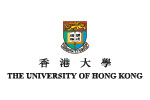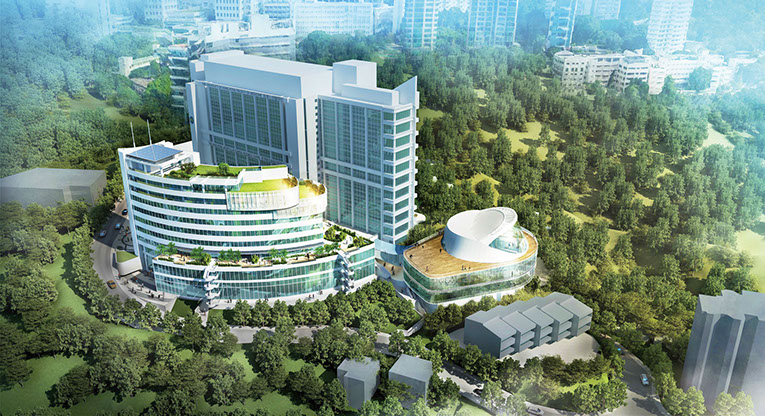
A wide array of activities, including academic conferences, reunions and outreach programmes, were held in 2017 in celebration of the 130th anniversary of the Faculty. The finale – the Homecoming Dinner – that took place at the Hong Kong Convention and Exhibition Centre in December, 2017 was attended by over 3,500 alumni, colleagues, students and friends of the Faculty.
The Li Ka Shing Faculty of Medicine was invited to join the China Consortium of Elite Teaching Hospitals in 2017.
HKU’s Dean of Medicine Professor Gabriel Leung, President of Institut Pasteur Professor Stewart Cole, and Chief Executive Officer of Hong Kong Science and Technology Parks Corporation Mr Albert Wong signed a Memorandum of Understanding in Paris in June, 2018 to set up a joint biomedical research centre.(Courtesy of François Gardy, Institut Pasteur)
Campus expansion
The most resource-intensive changes are happening on Sassoon Road. In early 2018, the government announced it would allocate HK$300 billion for hospital and teaching facility development, including upgrading and increasing teaching facilities. The Dean had long been planning to improve the medical campus and now has the means. “This is a golden opportunity for us. My vision is that Sassoon Road will be transformed into one contiguous, state-of-the-science campus cascading from Queen Mary Hospital all the way down to the intersection with Victoria Road,” he said.
This expansion comprises several components that will eventually be connected by walkways. At the base is 21 Sassoon Road, the main medical complex which opened in 2002 but long ago ran out of extra space. A new three-storey annex is being built next to the open-air carpark to house administrative offices and free space in the William MW Mong Block for teaching and learning. The library is also being upgraded to a Learning Commons with a variety of learning spaces.
Further along, the Faculty has been given 3 Sassoon Road, where a hospital laundry was located and which will now be redeveloped into a nine-storey building to provide a permanent home for the School of Nursing and School of Chinese Medicine. Two other Faculty buildings, at 7 and 8 Sassoon Road, are also being renovated and fitted with state-of-the-art equipment.
At Queen Mary Hospital itself, the University Pathology Building, which dates back to 1959, will be demolished to make way for a larger new block. The Departments of Pathology and Microbiology have moved out of the older building to an interim home (Block T) on the hospital grounds that offers them additional space. They will have a new purpose-built block when the second phase of the hospital’s redevelopment is completed around 2024.
In addition to Sassoon Road, the Faculty will establish Hong Kong’s first academic cancer centre at Grantham Hospital, which is itself being redeveloped. The Jockey Club pledged HK$1.24 billion for a translational research block that will also be completed around 2024 and support personalised and precision medicine, as well as Hong Kong’s first one-stop patient centre for psychosocial cancer care.
Enriching education
The 131-year-old Faculty’s curriculum has evolved rapidly in recent years. For more than a century, its main task was to train doctors using the same tried-and-tested methods. That started to change about 20 years ago with the introduction of Bachelor’s programmes in nursing then Chinese medicine, and the adoption of problem-based learning. In the past decade two new programmes were introduced – pharmacy and biomedical sciences. In the past five years, overseas exchange cum articulation programmes have been organised for biomedical sciences students in veterinary surgery, physiotherapy, radiography and public health. And starting in September, 2019 a new interdisciplinary Bachelor of Arts and Sciences in Global Health and Development will be launched jointly by the Medical, Architecture, Business and Economics, Science and Social Sciences Faculties.
The rapid expansion of programme offerings– and increase in student numbers that has entailed – has not been at the expense of quality and relevance. The flagship MBBS programme to train doctors has undergone a truly innovative change with the introduction of the Enrichment Year in the third year of study. Students have freedom to choose what and where to do their learning – they can go on exchange trips to top universities in Europe, North America and Australia, pursue intercalated degrees to get an additional qualification, undertake research projects abroad or at HKU, or join service and humanitarian projects in the least privileged corners of the world.
The first class to benefit embarked on their Enrichment Year in September, 2018. Examples of their activities include doing DNA research at Yale, studying humanities at Oxford, interning with the World Health Organization (WHO), studying Chinese medicine and German culture, and volunteering in a children’s home in Yunnan province.
“We want our students to take charge of their learning and have the space and latitude to explore and discover before the demands of their bedside training begin. We also want them to broaden their worldview,” said Professor Leung. “I am unaware of any other medical school that has tried this approach and I am very excited by the wonderful options that our students have come up with. Everyone in the Faculty is looking forward to the wealth of experience they will bring back to HKU next year.”
Mainland engagement
A third area where the Faculty is flowering is in its engagement with Mainland China. The Faculty has long been active with its Mainland counterparts through research collaborations, meetings and the like. This engagement began to be ramped up with the opening of the HKU-Shenzhen Hospital in 2012, which has overcome initial teething issues and become a platform for deeper cooperation. In the past two years, the Hospital has been certified as ‘3A’ in Guangdong meaning it can train interns in various specialities, and it has permission to do Phase 1 to 4 clinical trials – all remarkable achievements for such a young facility. Most recently, it was one of nine provincial hospitals selected for ‘Project Summit’ to develop various domains of excellence, with total additional funding exceeding RMB 1 billion. HKU-affiliated teaching hospitals also received favourable recognition in a recent ranking of hospitals in the Chinese-speaking areas (including the Mainland, Hong Kong, Taiwan and Macau). Queen Mary Hospital was named the 3rd best hospital overall and Hong Kong Sanatorium and Hospital 21st.
Alongside this recognition, the Faculty had the honour of being invited to join the China Consortium of Elite Teaching Hospitals in 2017. The Consortium comprises nine of the country’s top teaching hospitals, which are working together to improve the country’s medical system through enhanced doctor training and advance the government’s ‘Healthy China 2030’ goals. “The Consortium marks a historical milestone in Hong Kong’s deep re-engagement with the Mainland through our professional contribution,” Professor Leung said. “This re-engagement will be a large part of our future, within and beyond the Greater Bay Area and the Belt and Road national narratives.”
The Faculty is also pursuing opportunities in Hong Kong and the region to make an impact through research collaborations and technology transfers. It recently signed a strategic agreement with Guangdong Pharmaceutical University and a new MoU [Memorandum of Understanding] with the Hong Kong Science and Technology Park on biomedical innovations. It is also the Asian hub of the Institut Pasteur of France and Karolinska Institutet of Sweden and the WHO’s Reference Laboratory for Influenza and Collaborating Centre for Infectious Disease Epidemiology and Control.
“Historically, we have excelled where circumstances have given us a niche or opportunity to lead. This is one of those moments and we very much look forward to making our mark and contributing to advances in medical training and knowledge and clinical care, in Hong Kong, the region and the world. With all of the opportunities we have been given in just a few short years, our ambitions are boundless,” Professor Leung said.
“This is a time of consolidation and execution, that is of transactional leadership. The focus is on the details and making sure we consistently achieve the highest standards. It is important to have vision and principles, but to deliver on them is even more critical.” That assessment by the Dean of Medicine, Professor Gabriel Leung, Helen and Francis Zimmern Professor in Population Health, was made in 2013 when he took up his position. He has indeed delivered on the details that were the focus back then – pursuing collaborative education opportunities for the different disciplines in his Faculty (medicine, nursing, Chinese medicine, pharmacy and public health), producing HKU’s first MOOC, upgrading platform research technologies, and commissioning two new hospitals, the HKU-Shenzhen (HKU-SZ) Hospital which opened in 2012 and the Gleneagles Hong Kong Hospital which opened in 2017.
But incredible new opportunities and a restless energy have enabled him to advance the Faculty much further. These advances will start to reach fruition in his second five-year term as Dean, which started in August, 2018.
The government has given the green light to funding new and long-hoped-for developments at the Sassoon Road campus, stretching from Queen Mary Hospital down to the main building at 21 Sassoon Road. The Hong Kong Jockey Club Charities Trust has given the Faculty (and HKU) its largest-ever single donation to build a new cancer care and research centre in Aberdeen. The curriculum has been the focus of innovations that include a third-year ‘off-book’ for medical students, new articulation programmes and the coming launch of a new cross-disciplinary degree. And engagement with Mainland China is stepping up, with the HKU-SZ Hospital gaining recognition to upgrade its services and the Faculty being invited to join a high-level consortium of China’s elite teaching hospitals.
“We are currently in the most fortunate position of being able to expand our space and pursue a visionary transformation, and it is not a moment too soon,” Professor Leung said. “Our student numbers have been increasing [MBBS intakes alone have nearly doubled since 2008 to meet demand for more doctors] and our staff numbers have grown alongside that. We have simply run out of space. We now will have the means to grow physically and to engage in the kind of blue-sky, forward-looking activities that will position us to truly lead in meeting the healthcare needs of the 21st century – in Hong Kong, the nation and the wider world.”
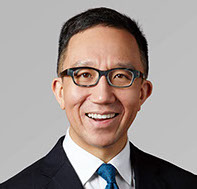
![]() We are currently in the most fortunate position of being able to expand our space and pursue a visionary transformation, and it is not a moment too soon.
We are currently in the most fortunate position of being able to expand our space and pursue a visionary transformation, and it is not a moment too soon. ![]()
Professor Gabriel Leung
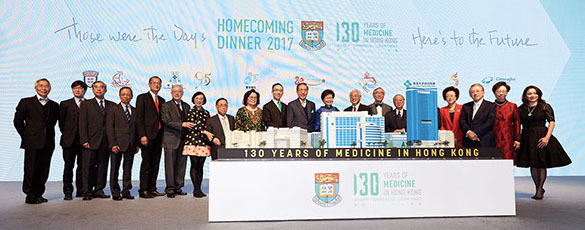
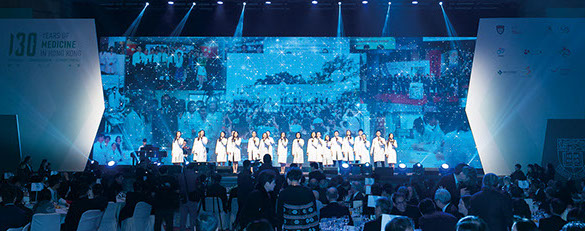
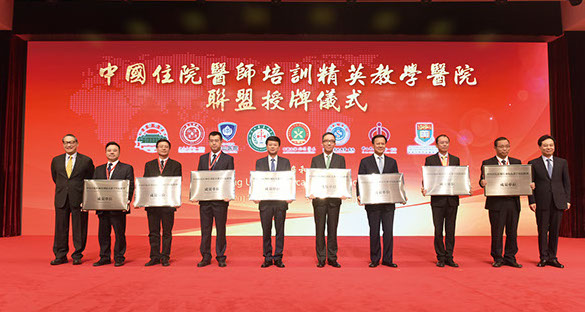
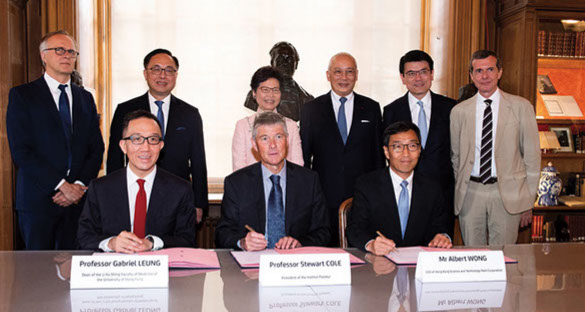
Li Ka Shing Faculty of Medicine is in the midst of an unprecedented physical and visionary expansion.
The Faculty leadership: (back row from left) Professor Gilberto Leung Ka-kit, Associate Dean (Teaching and Learning); Professor Chan Ying-shing, Associate Dean (Development and Infrastructure); (middle row from left) Professor Gabriel Leung, Dean of Medicine; Professor Leung Suet-yi, Associate Dean (Research); (front row from left) Professor Leung Wai-keung, Associate Dean (Human Capital); Professor Joseph Lui Cho-ze, Associate Dean (Clinical Affairs).
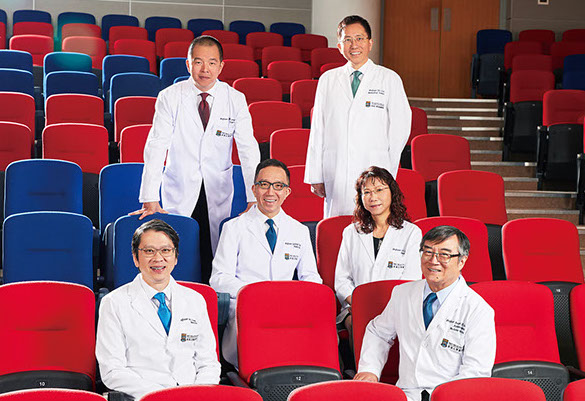
The first class of MBBS students embarked on their Enrichment Year in September, 2018. Students have the freedom to choose what and where to do their learning – going on exchange trips to top universities, pursuing intercalated degrees, joining service and humanitarian projects all over the world.
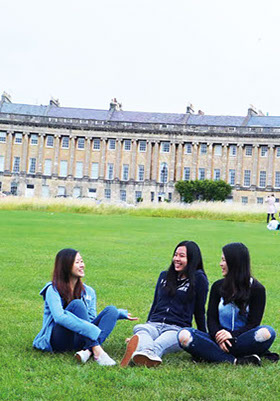
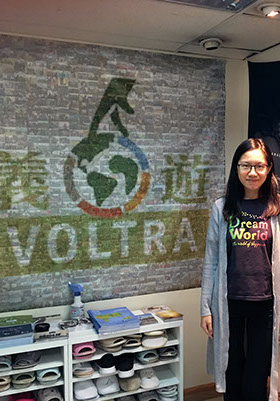
BIGGER, STRONGER,
BOLDER: NEW HORIZONS
FOR THE MEDICAL FACULTY
![]() We now will have the means to grow physically and to engage in
We now will have the means to grow physically and to engage in
the kind of blue-sky, forward-looking activities that will position us to truly lead in meeting the healthcare needs of the 21st century – in
Hong Kong, the nation and the wider world. ![]()
Professor Gabriel Leung
The Medical Faculty is taking forward a large-scale expansion and development plan in which the Sassoon Road will be transformed into one contiguous, state-of-the-science campus cascading from Queen Mary Hospital all the way down to the intersection with Victoria Road.
Home
November 2018
Volume 20
No. 1
